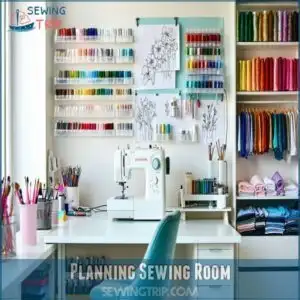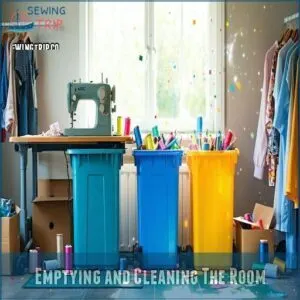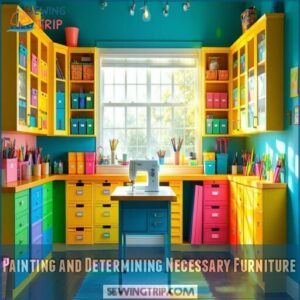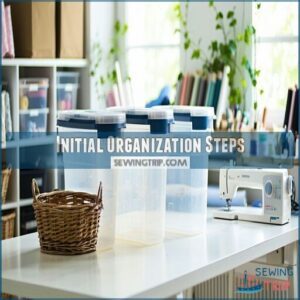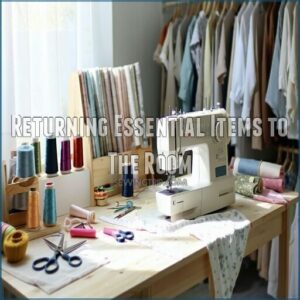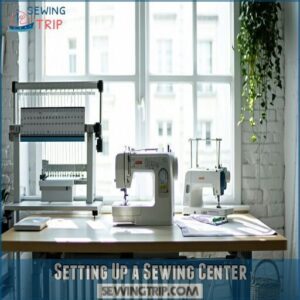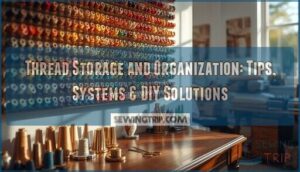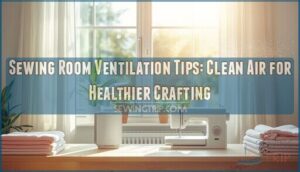This site is supported by our readers. We may earn a commission, at no cost to you, if you purchase through links.
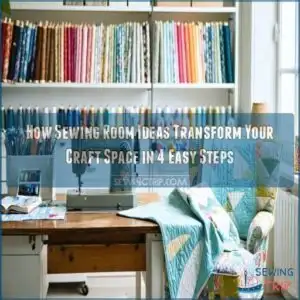
Use sewing room ideas from Pinterest to spark inspiration, but make it your own. Clear the space, grab some paint, and arrange furniture to soak up natural light (trust me, your eyes will thank you).
Organize supplies into zones—think fabric stash here, tools there. Add personal touches like framed patterns or a funky pin cushion.
And don’t forget music or a comfy chair for brainstorming! Ready to stitch up your dream space? Let’s go!
Table Of Contents
Key Takeaways
- Organize your sewing room into functional zones like cutting, pressing, and sewing for better workflow.
- Maximize natural light by positioning your sewing table near windows and adding task lighting for detail work.
- Use labeled bins, pegboards, and clear containers to keep supplies tidy and easy to find.
- Add personal touches like framed patterns, colorful decor, or music to make the space inspiring and enjoyable.
Planning Sewing Room
You’ll save yourself hours of frustration and fabric chaos by sketching out your sewing room plan before moving a single pin cushion.
With thoughtful planning of your space, lighting, and storage needs, you can transform even that cluttered corner of your guest room into a creativity haven where inspiration flows as smoothly as your favorite thread through a well-oiled machine, creating a space that fosters imagination and productivity, making it a well-oiled machine for your sewing projects, and ultimately becoming your own personal inspiration flows.
Transform any corner into a creativity haven where inspiration flows and every stitch fuels your imagination and productivity.
Utilizing Pinterest for Inspiration
Pinterest boards are your secret weapon for sewing room inspiration.
Start by creating a digital mood board with at least 50 pins to spot patterns in your style preferences.
Browse sewing room organization ideas, color palettes, and space-saving solutions that catch your eye.
You’ll quickly see which Pinterest trends resonate with you, making it easier to visualize your perfect space before moving a single piece of furniture.
Choosing The Right Space
Now that you’ve gathered inspiration, let’s find your perfect sewing spot. The right space should match how often you’ll sew.
Look for good lighting—natural light by windows works wonders for seeing thread colors correctly. Consider optimizing furniture with adjustable height options to prevent fatigue.
Find a distraction-free zone where you can leave projects out. Small sewing room ideas work even in tight spaces—remember, you just need enough room for you and your machine!
Considering Dual-Purpose Rooms
The beauty of dual-purpose rooms lies in their flexibility.
Don’t have a dedicated sewing space? Transform your guest room, playroom, or home office into a shared craft space with smart multipurpose furniture.
A fold-down table can become your cutting station, while storage ottomans hide supplies when company arrives. Vertical shelving maximizes your sewing room organization without sacrificing floor space.
Your sewing room ideas just need creativity, not square footage!
Discussing Space-Sharing With Family
When sharing your sewing space with family, open communication becomes your best pattern for success.
Before setting up your craft corner, have a family meeting to address:
- Family needs – Discuss how the space serves everyone, not just your sewing projects
- Schedule conflicts – Create a usage calendar to avoid overlapping activities
- Noise levels – Agree on quiet hours when machine humming won’t disturb others
Remember to respect boundaries and assign shared responsibilities for keeping the area tidy.
Setting Up Sewing Space
You’ll transform your chaotic craft corner into a functional sewing haven by starting with a clean slate and thoughtfully arranging furniture to catch that perfect natural light.
Just like a blank canvas awaits your creative stitches, your empty room now invites you to build the ideal workspace where every pin, pattern, and fabric scrap has its perfect home, creating a space that is truly a functional sewing haven.
Emptying and Cleaning The Room
Now that you’ve got your plan in mind, it’s time to roll up your sleeves.
Start your sewing room decluttering by completely emptying the space—except for large furniture. This "blank canvas" approach helps you assess the room without distractions.
Create a pre-cleaning checklist, then tackle surface clearing. Consider ergonomic comfort needs during this stage to prevent strain.
Set up three containers: one for trash disposal, one for donations (perfect for fabric you’ll never use), and one for items to relocate.
Painting and Determining Necessary Furniture
Your sewing room’s color scheme can dramatically impact your creativity and mood.
Transform your space with these smart furniture choices that maximize both function and style:
- Paint filing cabinets in energizing colors for cohesive storage
- Install floor-to-ceiling cabinets to hide clutter and maximize space
- Add a central island for additional workspace on a budget
- Choose ergonomic furniture for comfortable, long sewing sessions
- Incorporate cubby-style shelves for frequently used items
Consider options for filing cabinet finishes to match your room’s aesthetic, and focus on maximizing space with smart furniture choices that enhance your overall sewing experience.
Placing Furniture for Optimal Natural Light
Now that you’ve selected your furniture, let’s position it to catch that golden glow! Place your sewing table perpendicular to windows to minimize glare while maximizing natural light on your workspace.
Consider light angles throughout the day—morning sewers might arrange differently than evening crafters.
Don’t block windows with tall cabinets. If necessary, add task lighting to complement natural light and reduce eye strain during detail work.
Initial Organization Steps
Three essential containers will jumpstart your sewing room organization journey.
Before diving in, consider the following steps to create a clean and organized space:
- Gather bins for trash, donations, and items to relocate
- Clear all flat surfaces completely
- Move everything to a temporary storage area like your dining table
- Sort fabrics and notions immediately as you remove them
This decluttering strategy creates a clean slate for your creative sanctuary without overwhelming you.
Organizing Sewing Supplies
You’ll transform your sewing chaos into a creative oasis when you sort essentials by frequency of use and assign each item its own home.
Just like finding that perfect missing button at the bottom of your notions box, the joy of an organized craft space will make your sewing time twice as productive and ten times more enjoyable.
Returning Essential Items to The Room
After purging your supplies, it’s time to bring back only what truly matters.
You’ll want to prioritize essentials that serve your weekly sewing needs. That fabric you use constantly? It stays.
Those buttons you haven’t touched in years? They don’t make the cut. Your sewing room layout will breathe easier when you’re selective, giving each item purpose and proper sewing room storage space.
Creating Zones for Different Activities
Now that your essentials are back in the room, let’s map out your creative territory.
Divide your sewing space into functional zones for different activities.
Your cutting zone needs ample workspace with tool storage nearby, while your pressing zone should be easily accessible but separate.
Consider flow optimization between zones for smooth project progression.
A dedicated space, like a sewing cutting table, can greatly improve efficiency.
Think about ergonomic considerations – you’ll thank yourself after hours of crafting!
Setting Up a Sewing Center
Transform your crafting corner by setting up a sewing center that flows with your creative process.
Arrange your stations in a U-shape for efficient workflow, keeping your machine, cutting table, and pressing station within arm’s reach.
Make certain your worktable sits at 28 inches for comfort, while your cutting table should be 36-40 inches high.
Consider using a dedicated sewing machine stand for ideal ergonomics.
Good lighting is essential—it prevents mistakes and reduces eye strain during those late-night project sessions, ensuring a smooth and efficient creative process.
Establishing a Home Base for Frequently Used Items
A well-organized home base for your frequently used sewing items becomes the heartbeat of your creative space.
Create a dedicated station where scissors, thread, and measuring tape are always within arm’s reach to maintain workflow efficiency. Consider arranging threads by color for easy selection.
Your home base should include:
- Clear containers for supply visibility
- Magnetic strips for metal tool accessibility
- Labeled shelving for quick inventory management
Don’t let precious creative time vanish hunting for notions, as this can hinder your ability to focus on the task at hand and make the most of your dedicated station.
Personalizing Sewing Space
You’ll transform your sewing space from just functional to truly yours when you add personal touches that spark joy and boost creativity.
Surround yourself with meaningful items like favorite fabrics displayed in glass jars or a wall of colorful thread spools that double as practical storage and cheerful decor.
Reviewing Pinterest Board for Inspiration
After spending time collecting ideas, it’s time to revisit your Pinterest board with fresh eyes. Those pins you’ve gathered now serve as your personal design consultant! Review your sewing room Pinterest boards regularly to identify patterns in your style preferences.
One key aspect is to examine ergonomic sewing considerations for a comfortable space. This step is crucial in creating an environment that supports your sewing needs.
| Pin Curation Technique | Benefits For Your Space |
|---|---|
| Color Grouping | Reveals your palette preferences |
| Storage Solutions | Highlights organizational needs |
| Layout Arrangements | Shows workflow priorities |
| Mood Boards | Captures the feeling you’re after |
This visual roadmap helps your sewing room design evolve from scattered ideas into a cohesive vision.
Displaying Loved Items and Adding Personal Touches
Making your sewing space truly yours breathes life into your creativity.
A personalized sewing space fuels creativity, turning every stitch into a joyful expression of your unique style.
Surround yourself with items that spark joy and inspiration while you work.
- Hang inspirational artwork or vintage sewing room decor where you’ll see it while crafting
- Display family photos in decorative frames for a personal touch
- Place favorite candles on shelves for both ambiance and delightful scents
- Incorporate meaningful decor that tells your story and fuels your passion
This approach will help you create a space that is not only functional but also inspirational, making your sewing sessions more enjoyable and productive.
Enhancing The Atmosphere With Music and Decor
Now that your favorite items are displayed, let’s bring your space to life with music and décor!
Music sets the perfect tone—whether you prefer energizing beats or calming melodies while stitching.
Choose sewing room décor that reflects your personality with a thoughtful color scheme. Blues and greens create a peaceful sewing room ambiance, while bright accents add energy.
Don’t forget functional décor like decorative bowls for small tools and LED lighting for that extra creative ambiance.
Involving Family in The Sewing Process
With beautiful decor creating your perfect ambiance, don’t forget that your sewing space can become a family hub too.
Turn your craft room into a place where relationships flourish alongside creativity by involving your loved ones in the process.
- Host mini Family Quilting Bees where everyone contributes a patch
- Try simple Kids Sewing Projects using scrap fabrics
- Create a "Skill Sharing" corner where family members teach each other techniques
- Document your Collaborative Designs in a special journal to build Generational Sewing Traditions
Frequently Asked Questions (FAQs)
How do you layout a sewing room?
Think of your sewing room as a puzzle—start with the biggest pieces like your sewing table and storage.
Arrange furniture near natural light, create activity zones, and leave space to move comfortably, considering it as a puzzle to ensure an efficient layout.
What is the best color for a sewing room?
You’ll want soft, calming colors like light blue, pale gray, or soft green for your sewing room.
These hues keep you focused and relaxed.
Add pops of vibrant tones in decor for a creative spark!
What not to do in a sewing room?
Don’t overcrowd your sewing room with unnecessary items—it’ll feel like sewing in a closet.
Avoid poor lighting; squinting’s no fun.
What is the best flooring for a sewing room?
Go for durable, easy-to-clean flooring like laminate, vinyl, or hardwood.
They handle dropped pins and fabric scraps well.
Avoid carpet—it’s a magnet for threads and needles, and trust me, your vacuum won’t thank you!
How much does it cost to set up a sewing room?
Rome wasn’t built in a day, and neither is a sewing room!
Costs range from $200 for DIY setups with thrifted items to $2,000+ for custom furniture, lighting, and storage.
Start small, upgrade gradually!
What are the best ways to keep the sewing room organized?
Keep your sewing room tidy by assigning every item a “home.”
Use labeled bins, pegboards, and clear containers for supplies.
Regularly declutter, group similar items, and keep your workspace clear to boost creativity and focus.
What type of lighting is best for a sewing room?
Lighting is the heartbeat of your sewing room.
Go for natural light by day and LED daylight bulbs at night.
Task lights near your machine and cutting table reduce strain, making every stitch a breeze!
Are there any sewing room safety tips to keep in mind?
Stay sharp—literally and figuratively!
Store scissors and needles safely, unplug machines after use, and keep cords untangled.
Use a sturdy chair, good lighting, and avoid clutter to prevent slips, trips, or pokes.
How do I make sure I have the right tools for my sewing room?
Don’t put the cart before the horse—start with basics like scissors, pins, and a seam ripper.
Add tools gradually as projects demand.
A pegboard or cart keeps everything handy and sparks joy!
How can I store sewing patterns efficiently?
Store sewing patterns by filing printed ones in labeled boxes, binders, or accordion folders.
For PDFs, use clear envelopes or project bags.
Keep them sorted by type or project, so finding the right one’s a breeze!
Conclusion
They say, "A stitch in time saves nine," and it’s true for creating your perfect sewing space.
By using these sewing room ideas, you’ll turn chaos into creativity in no time.
Start with a plan, set up your space with natural light, and organize your supplies into zones.
Add personal touches that make it uniquely yours—maybe some music or quirky decor.
With a little effort, you’ll have a cozy, functional space that inspires every project, making it a place where you can enjoy your hobby and express your creativity.

